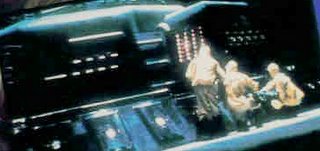I liked the 3-D show, "Still Life," (directed by Voyager's Tom Paris, Robert Duncan McNeill!) quite a bit, though I probably could have done without the introduction by the late Rod Serling. Though it was nice to pay homage to this brilliant early TV artist, I could tell he had been given a CGI mouth, and whoever was doing the vocal impression simply wasn't very good. I guess that for the general masses, this black-and-white intro would have passed muster, but for those of us who watch Night Gallery and Twilight Zone obsessively (me, me!) you could tell the diction and enunciation wasn't Serling's. "Your next stop, The Medium Zone," just doesn't really cut it as a lead-in, either. I didn't mind 3-D as a gimmick, but maybe the Serling intro was just too gimmicky...
Still, the drama that followed the Serling introduction was quite a lot of fun. Watching "Still Life", I was struck with the (obvious) notion that this is essentially the same show as Ghost Whisperer on CBS... only without all the quality scientifically extracted. Instead, both episodes of Medium that I watched (on tape) featured strong third-act twists, (in other words, good writing...) and didn't resort to pat messages about the afterlife. Ghost Whisperer amuses me because spirits come back from the dead just to say pat things like "I forgive you," or "I love you." My theory on that is that we have our whole life span to share with our loved ones these very messages, and if we don't manage to do it during that time, I doubt very much that the universe is going to give us a second chance.
Wisely, Medium features much more substantial mysteries about spirits, ESP and the afterlife. In "Still Life," the mystery leads back to the genetic heritage of a guest character, the son of John Shea (late of Mutant X and Lois & Clark), and it was cleverly vetted. I also liked that Medium's producers aren't afraid to permit the show to dwell on the darker side. There's a murder "flashback" set in a kitchen in "Still Life." In it, a maid is brutally attacked with a butcher's cleaver. The weapon is hurled at the screen/camera (in 3-D) and I loved it!!! Then, there was a scene of creepy imagery involving a gnarled old tree - one where sneakers dangle mysteriously from high branches, hanging on by their laces. Beneath the tree trunk, a murder with a shovel occurs, and again, the series pulls no punches in depicting it. To me, this approach makes the show much more watchable than the treacly and essentially harmless Ghost Whisperer.
To continue that comparison, I also prefer the relationship between Allison DuBois (Arquette) and her husband, Joe (Jake Weber of American Gothic!) to the spousal relationship featured on Ghost Whisperer, which is cheesy and forced. Allison isn't histrionic about her powers (like Love Hewitt's character...), but rather more melancholy, and I enjoy watching Joe's attempts to keep her grounded and her chin up. It also helps, I must say that these characters are nearing 40. They aren't your typical "young" supermodels, and there's something between the lines here...a world-weariness, humanity and reality that is entirely missing from Ghost Whisperer. Life doesn't resemble a movie back-lot on Medium, and I appreciate that. For instance, I like how Joe and Allison play with each other, gently prodding and pushing one another with sarcasm and a love that borders on irritation. I like that they share "brewskies" together after a tough day, and I like the fact that their house looks like one a middle-class family could actually afford; again, unlike the over-designed, unrealistic Ghost Whisperer. It's amazing how two shows can share such similar premises but one is so strong, the other so weak.
But that's an argument for another post, I suppose. "Reckoning," Monday's episode of Medium involved a hit and run "accident" and the year-long fall-out that followed. A 15-year old girl, Melanie Davenport was killed while chasing her dog into the street, and the perpetrator, James Massey, has kept it a secret ever since. It's driven his wife to suicide (he was the driver!) but now her spirit is back...
This episode had several twists (particularly in the third act), and a truly appalling (but fascinating) sequence involving James' police interrogation, wherein he puts all the blame on his dead wife. Wow, that's particularly shameless. The episode also featured a great line from Joe that I'm sure I'll steal: "Mediocre minds think alike."
In the "scare" category, "Reckoning" also featured a solid, eerie moment. Hit-and-run driver James stands in his kitchen smoking by the oven when a face materializes behind him in a wisp of his cigarette smoke. Yikes! The ending also featured a great twist, a sense of "cosmic justice" that was more worthy of a Twilight Zone narration than the Serling intro in "Still Life."
Both of these episodes of Medium were very enjoyable, and kept me entertained...even wanting more at the end. So I guess I'm hooked. Anyone out there watch this show regularly? Fill me in! What have I been missing?


























